Spotted fish
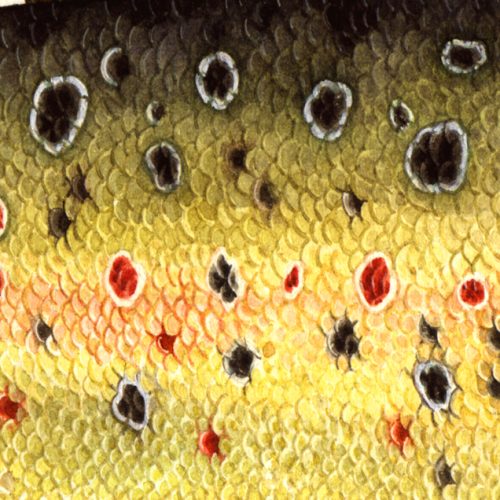
Spotted fish is another of my blogs on patterns in nature. You can find them all here or click for an overview of pattern in nature, more on stripes, leaf variegation, spots on plants and fugus, and a step by step of a variegated geranium leaf.
How spots are formed
According to Study.coms post on patterns in nature, pattern is defined as, “a consistent form, design, or expression that is not random”. The patterns that are favoured by natural selection will become common across a species, but how do these patterns come about?

Six spot burnett moth Zygaena filipendulae showing spots
Alan Turing explored this problem in “The Chemical basis of morphogenesis” in 1952. He discovered that chemicals moving across embryonic cells cause patterns. There are activators (which increase the amount of two chemicals which mix together to create dark pigment). And there are inhibitors (which decrease the concentration of the two chemicals, prohibiting production of pigment.) When this occurs in alternating areas you see spots. The colour is produced by melanophore or chromatophore cells. This is known as the Turing Model, and has been explored repeatedly since the 1950s, notably by Jeremy Green in Developmental Biology in 2015. For more on the Turing Model click here.
Why are spots formed?
As discussed in my overview of pattern in nature, patterns are formed for a variety of reasons. Some are used to protect from predation and camouflage. Some are used to hide predators. Some trick potential predators into avoiding an animal which resembles another species that has dangerous traits or an unpleasant flavour (Batesian mimicry). Patterns can be used to attract mates or frighten off competition looking to steal your mates or territory. So why do fish wear spots? Below are some examples.

Wasp beetle showing Batesian mimicry. It is harmless but resembles a wasp which puts off potential predators.
Trout and spots
The Brown trout Salmo trutta are covered in beautiful black and red spots, outlined in white.
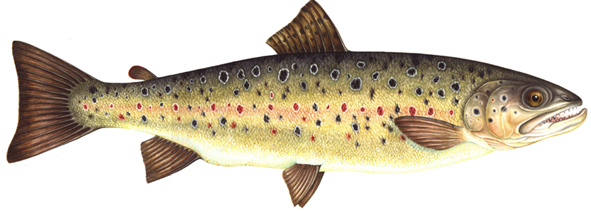
Brown trout Salmo trutta
There are various reasons for this design. The spots become brighter during mating which suggests they play a role in mate selection, and fish flash their colourful spots at potential competitors for females in lateral and frontal displays (Tim Travers 2014).
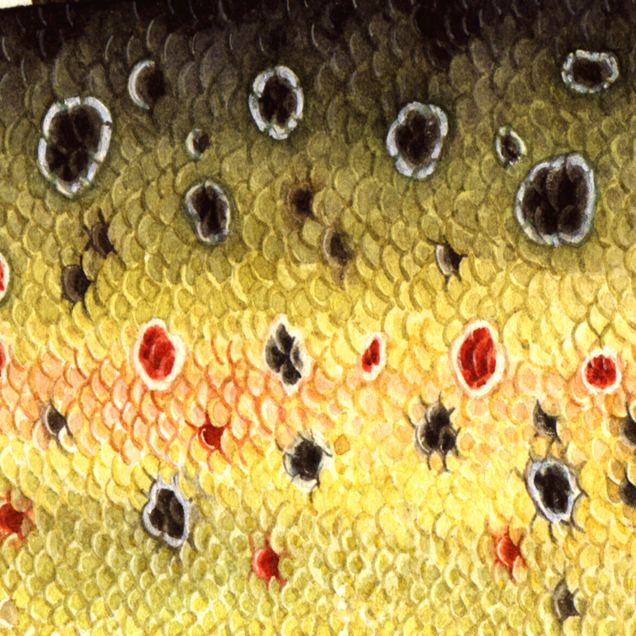
Close up of Brown trout pattern
They also help camouflage the fish, breaking up their outline from above and blending in with both reflected light and the speckled stones of shallow stream beds.
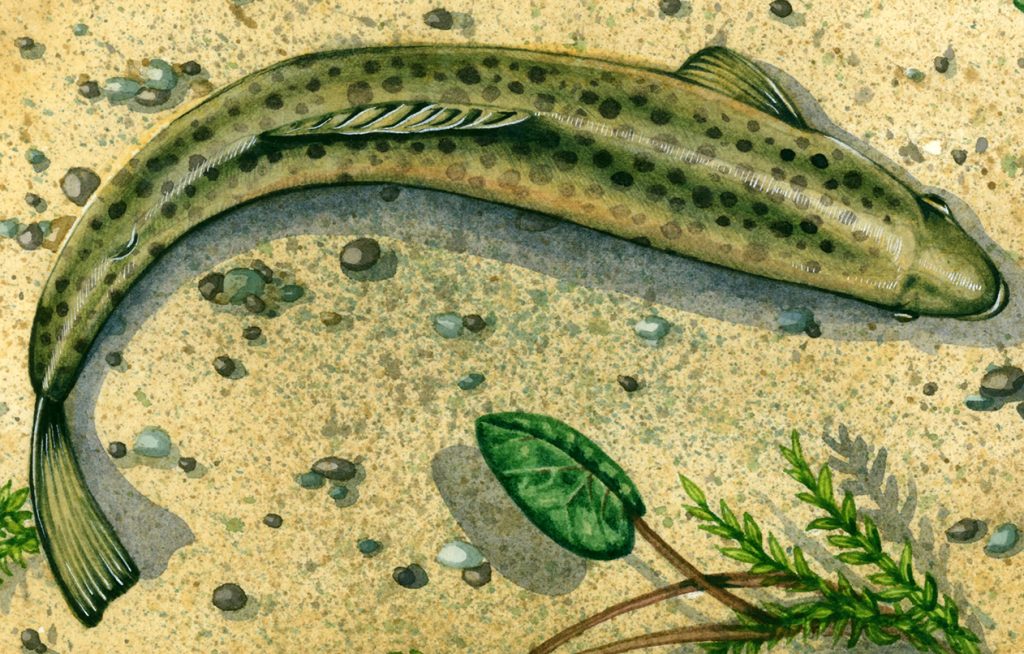
Brown trout swimming, seen from above
Tim Travers also suggests that the trout’s environment has led to the spots. Evolving in crystal clear cold and glacial water, markings are visible to potential mates and rivals and therefore worth investing in.
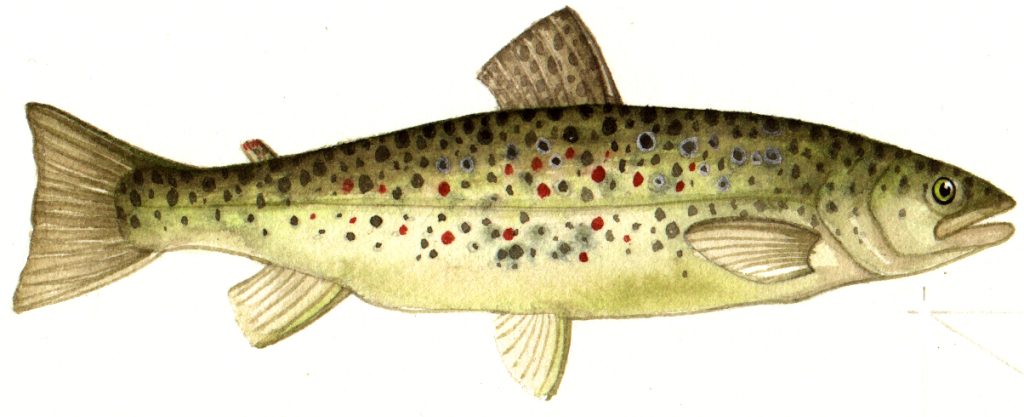
Brown trout Salmo trutta sketch
Salmon and spots
Another spotted fish is the Salmon, Salmo salar.
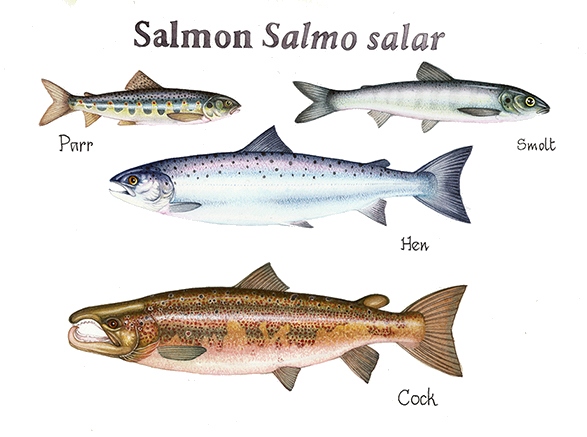
Life cycle of the Salmon
Compared to similar fish in the Salmo family, such as Brown or Sea trout, the Salmon is relatively clear of spots. However, they appear on the youngest fish, the parr, as red dots on the flanks and black dots on the back and dorsal fin.

Salmon parr
The next life stage, the smolt, has less spots, only a few on the back and gill cover.

Salmon smolt
The final stage sees the adult female hen salmon with lots of dark spots, and the male, in breeding colours, sporting red and brown and black dots.

Hen salmon
Male, or cock salmon also develop spots at mating time. These are a complex network of red and black dots, overlaid on other blotches of colour. Some anglers call the pattern a “tartan” because of its complexity.

Cock salmon
For more on the lifecycle of salmon look at my earlier blog or the Atlantic Salmon Trust’s page.
Salmon spots on wild vs farmed fish
There’s interesting research that suggests farmed salmon are up to 7 times more spotty than wild salmon. As these patterns are laid down during the early smolting stage and are stable throughout a lifetime, seeing how spotty a river fish is can be used to figure out whether it is wild or an escaped animals (How does a salmon get its spots 2018 Jorgenson, Solberg and Glover). The same consistency of pattern allows researches to identify individual fish, and could lead to less invasive and stressful forms of research on wild populations (FishBio 2018).
Puffer fish and spots
Pufferfish and box fish are often covered in little spots. I could not find research pointing to what function these markings serve, they could be for communication, warning, mate choice, but are probably not a form of camouflage. Perhaps it relates to the toxicity of some species and their ability to puff up by inhaling water if attacked?
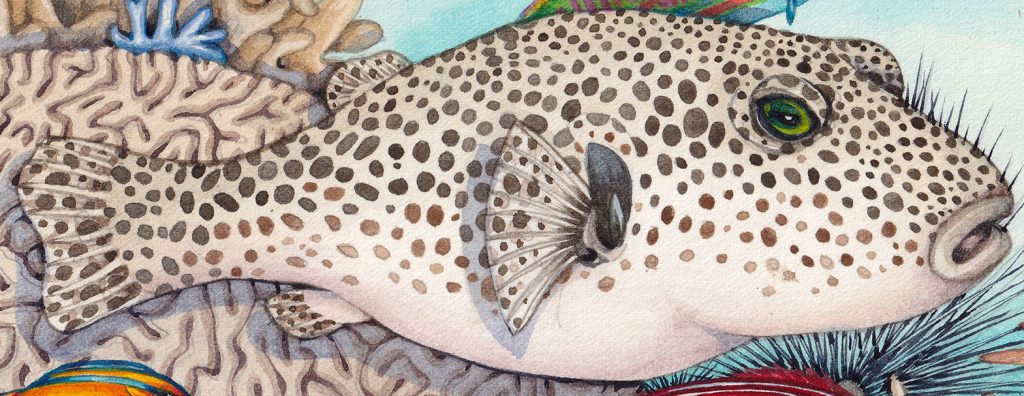
Starry puffer Arothron stellatus
Sometimes these can be concentric circles of colour. In Diffusiophoresis-enhanced Turing patterns 2023, Benjamin Alessio explains how these spots are formed. Based on the Turning model, diffusiophoresis shows how moving molecules bring other nearby molecules along with them. If these molecules are colour-producing chromatophores, you get different areas of colour. This research was done on the Ornate box fish, a close relative of the puffer fish.
Turbot
Turbot are another spotted fish. They are members of the flat fish family and have replaced their scales with skin and bony bumps called tubercles. Turbot are able to change colour, literally changing their spots. The skin has chromatophores producing black, red and yellow pigment. Although these cells are in the same position, they can be turned on and off, allowing the fish to change colour in a matter of minutes or in some species, seconds.
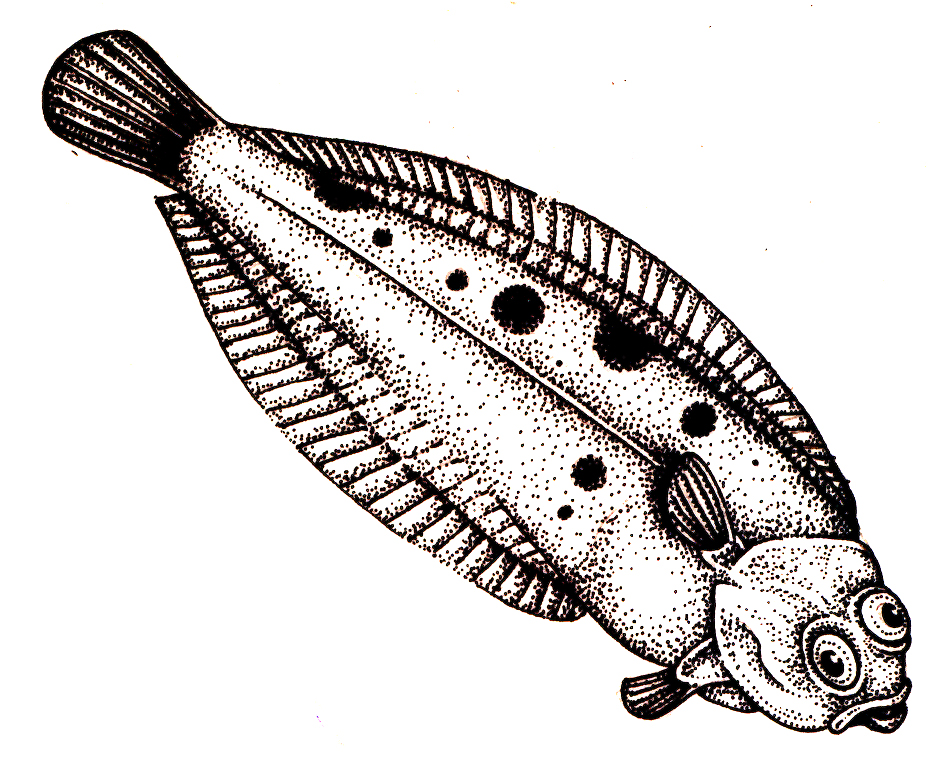
Juvenile Turbot turbot Scophthalmus maximus
They are also remarkable in that their bodies twist as they develop, meaning the adult has one eye which has migrated 90 degrees around its body. This allows the fish to be incredibly flat. Adult fish flap to stir up sand, and once a sprinkling of this lies on top of the spotted fish, it is indistinguishable from the sandy bottom of the sea floor. Turbot spots make this fish a master of camouflage.
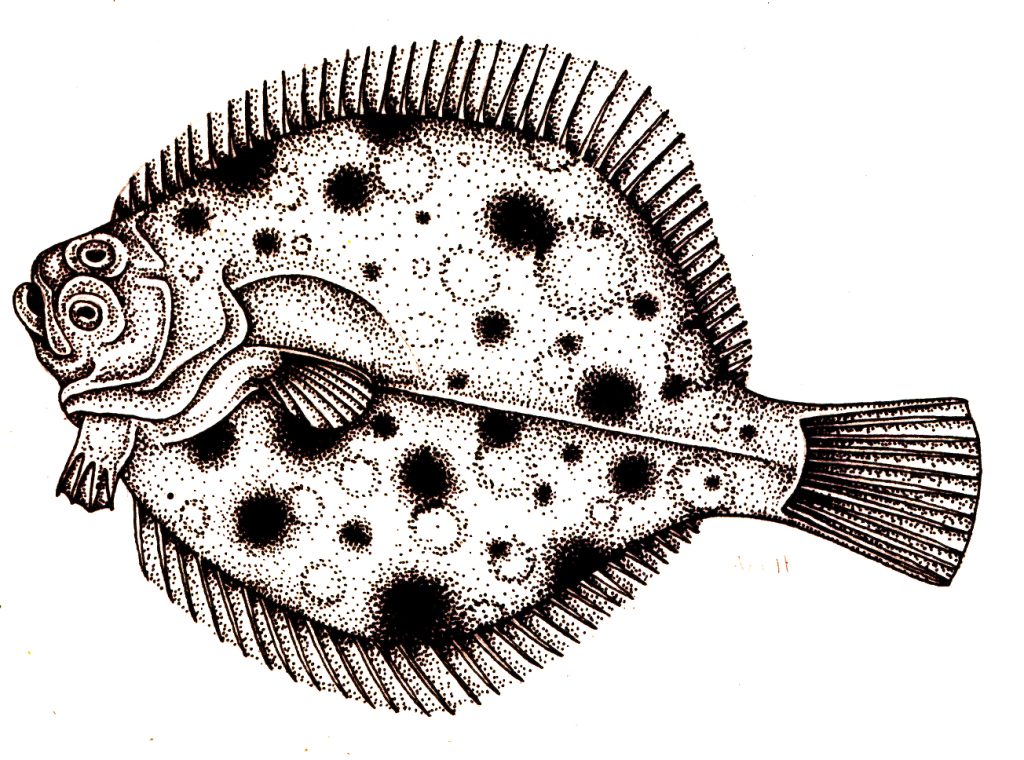
Adult turbot Scophthalmus maximus
For more on flatfish camouflage, have a look at Changeable Camouflage: How well can flounder resemble the colour and spatial scale of substrates in their natural habitats? by D. Akkaynak et al 2017 in Royal Society Open Science.
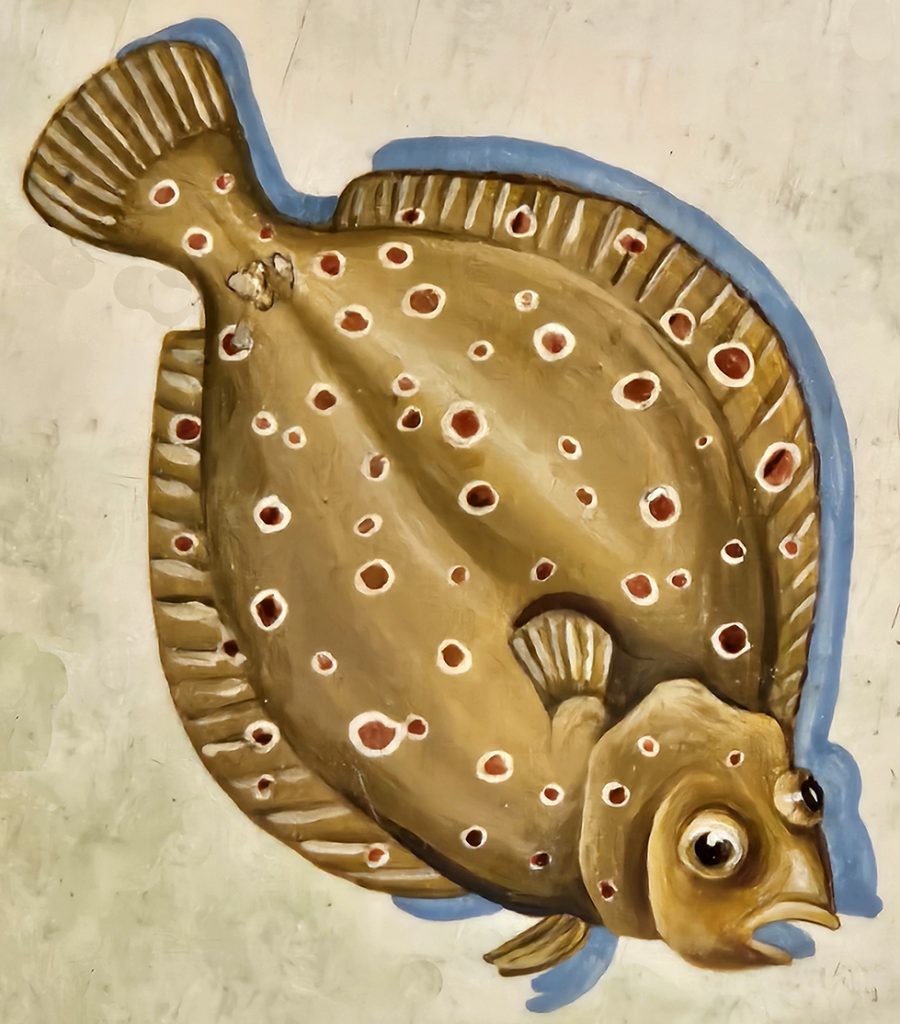
Sketch of the Plaice Pleuronectes platessa another colour-changing flatfish species
Leopard shark spots
The Leopard shark is also known as the Zebra shark because it has stripes when it is young. These morph into spots as the shark ages. It is thought that these different stages allow the markings to fufill different functions.
When young, the stripes break up the outline of the baby shark. Lots of striped sharks together are confusing for a predator meaning it is less likely to fix on one individual animal. This is known as the Predator dilution effect. The markings could also send a message to territorial fish, informing them that a baby shark is in no way a threat and therefore is not worth fighting. It could even be a form of Batesian mimicry as the stripes resemble those on venomous sea snakes. (The Sandy Zebra Shark: A new colour morph in Copeia by Dahl 2019)

Zebra or Leopard shark Stegostoma tigrinum
The shark undergoes ontogenetic change before adulthood. This means a change in appearance which is genetically linked to the age of the animal. The adult shark emerges with distinctive spots. Because this change occurs at sexual maturity, it’s been suggested that the spots may be involved in mate choice and breeding. (A Zebra that changes its spots by Sophie Maycock 2020).
Conclusion
This is the very tip of the iceberg when considering spotted fish. Stingrays, Zebrafish, Triggerfish, Grouper, Guppies, Cichlid, and Surgeonfish can all be covered in dots. It is much easier to find out what a fish with spots looks like than it is to untangle why it wears this livery. Whether monotone or multicoloured, single spots or concentric rings and circles, one thing is certain. The patterns on fish are stunning, and a real joy to illustrate and research.
For a whole lot more on colouration in fish, read Price et al’s overview in Pigments Patterns and Fish Behaviour in Zebrafish 2015.

